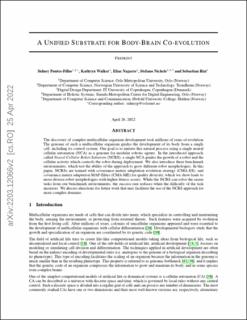| dc.contributor.author | Pontes Filho, Sidney | |
| dc.contributor.author | Walker, Kathryn | |
| dc.contributor.author | Najarro, Elias | |
| dc.contributor.author | Nichele, Stefano | |
| dc.contributor.author | Risi, Sebastian | |
| dc.date.accessioned | 2023-08-16T12:04:22Z | |
| dc.date.available | 2023-08-16T12:04:22Z | |
| dc.date.created | 2022-07-23T14:27:05Z | |
| dc.date.issued | 2022 | |
| dc.identifier.isbn | 9781450392686 | |
| dc.identifier.uri | https://hdl.handle.net/11250/3084392 | |
| dc.description.abstract | The discovery of complex multicellular organism development took millions of years of evolution. The genome of such a multicellular organism guides the development of its body from a single cell, including its control system. Our goal is to imitate this natural process using a single neural cellular automaton (NCA) as a genome for modular robotic agents. In the introduced approach, called Neural Cellular Robot Substrate (NCRS), a single NCA guides the growth of a robot and the cellular activity which controls the robot during deployment. We also introduce three benchmark environments, which test the ability of the approach to grow different robot morphologies. In this paper, NCRSs are trained with covariance matrix adaptation evolution strategy (CMA-ES), and covariance matrix adaptation MAP-Elites (CMA-ME) for quality diversity, which we show leads to more diverse robot morphologies with higher fitness scores. While the NCRS can solve the easier tasks from our benchmark environments, the success rate reduces when the difficulty of the task increases. We discuss directions for future work that may facilitate the use of the NCRS approach for more complex domains. | en_US |
| dc.language.iso | eng | en_US |
| dc.publisher | Association for Computing Machinery (ACM) | en_US |
| dc.relation.ispartof | GECCO '22: Proceedings of the Genetic and Evolutionary Computation Conference Companion | |
| dc.title | A single neural cellular automaton for body-brain co-evolution | en_US |
| dc.title.alternative | A Unified Substrate for Body-Brain Co-evolution | en_US |
| dc.type | Chapter | en_US |
| dc.type | Peer reviewed | en_US |
| dc.type | Conference object | en_US |
| dc.description.version | acceptedVersion | en_US |
| cristin.ispublished | true | |
| cristin.fulltext | original | |
| cristin.qualitycode | 1 | |
| dc.identifier.doi | https://doi.org/10.1145/3520304.3529002 | |
| dc.identifier.cristin | 2039192 | |
| dc.source.pagenumber | 148-151 | en_US |
| dc.relation.project | Norges forskningsråd: 270961 | en_US |
